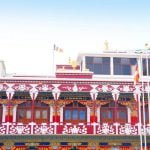Nestled in the sacred town of Bodhgaya in Bihar, India, the Bodhi Tree stands not merely as a tree but as the spiritual axis of the Buddhist world. It is here, under the shade of this revered peepal tree (Ficus religiosa), that Prince Siddhartha Gautama attained enlightenment over 2,500 years ago and became Lord Buddha. This hallowed site is not just a historical landmark but a living symbol of peace, awakening, and the timeless teachings of the Buddha.

The Enlightenment of the Buddha: A Moment That Changed History
Around 528 BCE, Siddhartha Gautama, after years of intense asceticism and meditation, chose to sit beneath a fig tree in Bodhgaya. Vowing not to rise until he had discovered the truth, he meditated through deep concentration and introspection. On the full moon night of Vaishakha (Buddha Purnima), he finally attained nirvana, breaking the cycle of birth and death.
This tree became the Bodhi Tree, and the place beneath it, Vajrasana (the Diamond Throne), marks the most sacred spot in Buddhism.
The Original Bodhi Tree and Its Descendants
The tree we see today is believed to be a direct descendant of the original Bodhi Tree. While the original tree was destroyed several times due to natural causes and invasions, a sapling from the original was taken to Sri Lanka by Emperor Ashoka’s daughter, Sanghamitta, and planted at Anuradhapura.
In the 19th century, a sapling from the Sri Lankan tree was brought back and planted at the same sacred site in Bodhgaya, restoring the lineage of the holy tree. Thus, the present Bodhi Tree is revered as a true continuation of the sacred lineage of enlightenment.
Mahabodhi Temple Complex: A UNESCO World Heritage Site
Surrounding the Bodhi Tree is the grand Mahabodhi Temple, an architectural marvel and a UNESCO World Heritage Site. Rising over 50 meters high, the temple is adorned with intricate carvings depicting scenes from the Buddha’s life. The Vajrasana, the actual seat of enlightenment, lies just behind the temple, shaded by the branches of the Bodhi Tree.
Pilgrims from across the world walk barefoot on this soil, circumambulating the tree, meditating, and offering prayers, experiencing the profound energy of this divine location.
Spiritual Practices Under the Bodhi Tree
Buddhists from different traditions—Theravāda, Mahāyāna, and Vajrayāna—converge under the canopy of the Bodhi Tree, united in their quest for spiritual wisdom.
Common rituals include:
- Silent meditation under the tree’s shade.
- Chanting of sacred sutras such as the Metta Sutta or the Heart Sutra.
- Prostrations and offerings of lamps and flowers.
- Circumambulating the Mahabodhi Temple, often 108 times as a symbol of purification.
- Sitting in deep mindfulness, emulating the Buddha’s journey.
Global Pilgrimage Destination: A Meeting Point of Faiths
The Bodhi Tree draws not only monks and devotees but also pilgrims from across cultures, including:
- Tibetan Lamas performing elaborate rituals.
- Sri Lankan devotees chanting in Pali.
- Japanese Zen monks engaged in Zazen meditation.
- Thai, Burmese, and Cambodian pilgrims offering incense and prayers.
- Western practitioners in silent retreat.
This cultural confluence makes the Bodhi Tree a beacon of unity and inner peace, transcending religious and geographical boundaries.
Important Festivals Celebrated at the Bodhi Tree
1. Buddha Purnima (Vesak)
Celebrated on the full moon of May, this marks the birth, enlightenment, and death of Buddha. The Bodhi Tree is adorned with lights, flowers, and thousands of butter lamps.
2. Kagyu Monlam Chenmo
A large prayer gathering organized by the Karma Kagyu sect of Tibetan Buddhism, drawing thousands of monks who chant prayers for world peace beneath the Bodhi Tree.
3. Nyingma Monlam
Another powerful prayer festival by the Nyingma school of Tibetan Buddhism, featuring vibrant rituals and traditional chants.
Historical Legacy: Ashoka’s Role in Preserving the Bodhi Tree
Emperor Ashoka, after embracing Buddhism, visited Bodhgaya in the 3rd century BCE. He was instrumental in:
- Constructing the first Mahabodhi Temple.
- Erecting the Vajrasana (Diamond Throne).
- Establishing a monastic community around the Bodhi Tree.
- Sending saplings to Sri Lanka and other Buddhist kingdoms, thus spreading the Bodhi Tree lineage globally.
Architectural and Spiritual Features Around the Tree
Vajrasana (Diamond Throne)
The sacred seat where Buddha attained enlightenment, crafted from polished sandstone by Ashoka.
Animesh Lochan Chaitya
A spot where Buddha spent a week meditating in gratitude, gazing unblinkingly at the tree.
Ratanaghara
Where the Buddha walked and left an imprint of his divine aura, marked with stone lotus symbols.
Chankramana (The Walking Path)
A stone-paved path where Buddha walked in meditation post-enlightenment.
Tips for Pilgrims Visiting the Bodhi Tree
- Visit early morning or at sunset to experience the serenity at its peak.
- Wear modest, respectful clothing—preferably white.
- Carry a meditation mat or shawl for personal sitting.
- Refrain from loud conversations—maintain the sacred silence.
- Participate in evening chanting sessions, often held by monks from various traditions.
Nearby Monasteries Worth Visiting
- Thai Monastery
- Tibetan Tergar Monastery
- Indosan Nipponji (Japanese Temple)
- Burmese Vihara
- Chinese Monastery
Each offers a unique spiritual flavor, enhancing the depth of your pilgrimage.
Conclusion: A Living Symbol of Enlightenment
The Bodhi Tree in Bodhgaya is not merely a historical artifact—it is a living monument of transformation, reminding us of our potential for inner peace, wisdom, and compassion. For every seeker, sitting beneath its branches is not just a visit—it is a spiritual homecoming, a moment to reflect, awaken, and walk the path the Buddha once walked.





